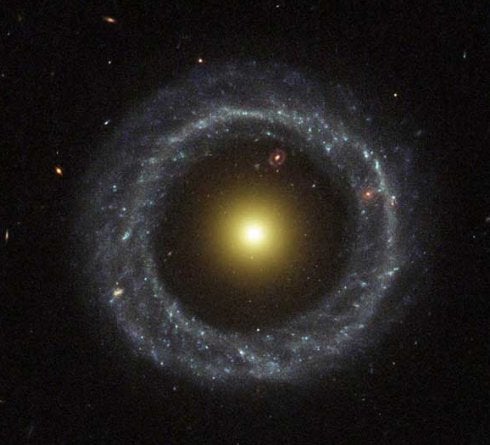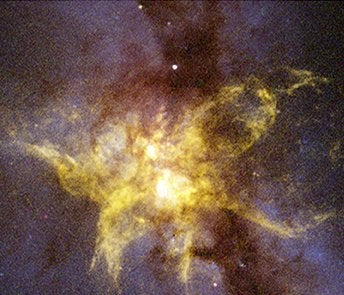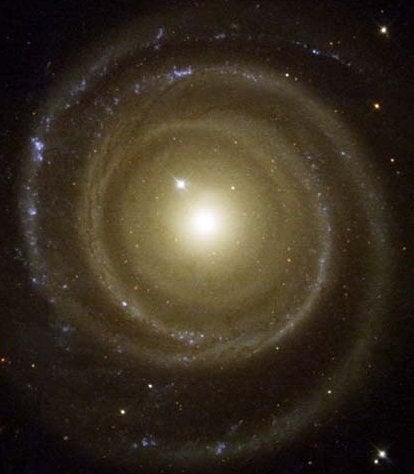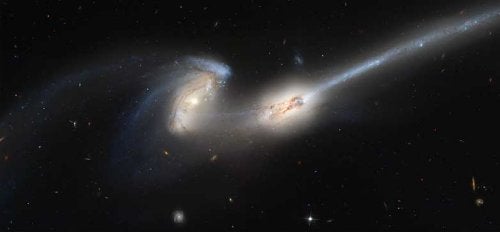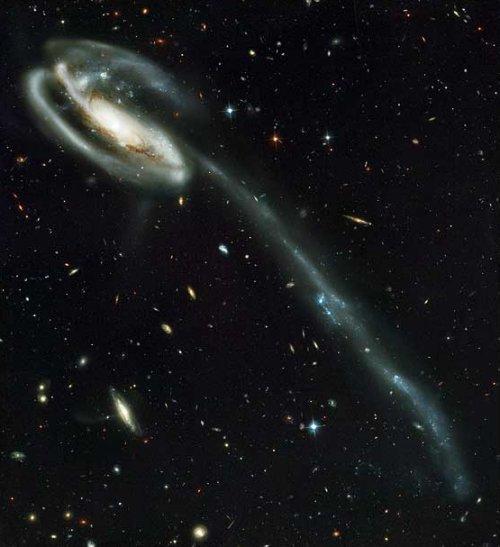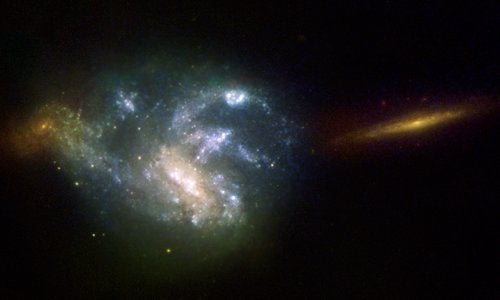Clusters of young, massive stars populate the bluish ring of the odd galaxy known as Hoag’s Object. This Hubble image captures the face-on ring around the yellowish glow of a normal elliptical galaxy. The elliptical galaxy is 15,000 light-years wide while the inner and outer diameters of the ring span 75,000 and 120,000 light-years. The ring most likely formed when the elliptical shredded a passing galaxy.
NASA / Hubble Heritage Team (STScI / AURA)
When galaxies collide, or even when they just come near one another, they can turn beautiful spirals or other tidy systems into messy, weird-looking galaxies. Here is a sample of some of these galactic oddballs.
Hoag’s Object
Clusters of young, massive stars populate the bluish ring of the odd galaxy known as Hoag’s Object. This Hubble image captures the face-on ring around the yellowish glow of a normal elliptical galaxy. The elliptical galaxy is 15,000 light-years wide while the inner and outer diameters of the ring span 75,000 and 120,000 light-years. The ring most likely formed when the elliptical shredded a passing galaxy.
NGC 6240
The unusual butterfly shape of NGC 6240 was caused by the collision of two smaller galaxies. The galaxy is located about 400 million light-years away in Ophiuchus.
The unusual butterfly shape of NGC 6240 was caused by the collision of two smaller galaxies. The galaxy is located about 400 million light-years away in Ophiuchus.
NGC 4622 is 111 million light-years from Earth in the constellation Centaurus. The Hubble Space Telescope imaged the galaxy on May 25, 2001. For years, the galaxy’s direction of rotation was a mystery because its two outer arms wrap one way while another inner arm curls in the opposite direction. Hubble observations eventually revealed that, unlike most spiral galaxies, it spins clockwise, the same direction its outer arms point as they extend from the galaxy’s core.
NASA / Hubble Heritage Team (STScI/AURA)
NGC 4622
NGC 4622 is 111 million light-years from Earth in the constellation Centaurus. The Hubble Space Telescope imaged the galaxy on May 25, 2001. For years, the galaxy’s direction of rotation was a mystery because its two outer arms wrap one way while another inner arm curls in the opposite direction. Hubble observations eventually revealed that, unlike most spiral galaxies, it spins clockwise, the same direction its outer arms point as they extend from the galaxy’s core.
NGC 4622 is 111 million light-years from Earth in the constellation Centaurus. The Hubble Space Telescope imaged the galaxy on May 25, 2001. For years, the galaxy’s direction of rotation was a mystery because its two outer arms wrap one way while another inner arm curls in the opposite direction. Hubble observations eventually revealed that, unlike most spiral galaxies, it spins clockwise, the same direction its outer arms point as they extend from the galaxy’s core.
Also known as NGC 4676, “The Mice” are a pair of nearly identical spiral galaxies seen during the early stages of a merger. They will eventually form one large elliptical galaxy. According to simulations, we are seeing this colliding pair approximately 160 million years after their closest encounter. The long tail on the right galaxy is actually curved, but appears straight because we see it edge-on. The formation of bright blue waves of hot, young star clusters (seen especially well in the left galaxy) has been triggered by the galactic interaction. The galaxies lie 300 million light-years away in the constellation Coma Berenices. This image was taken on April 7, 2002, by the Hubble Space Telescope’s Advanced Camera for Surveys.
NASA / ACS Team (H. Ford et al.)
The Mice
Also known as NGC 4676, “The Mice” are a pair of nearly identical spiral galaxies seen during the early stages of a merger. They will eventually form one large elliptical galaxy. According to simulations, we are seeing this colliding pair approximately 160 million years after their closest encounter. The long tail on the right galaxy is actually curved, but appears straight because we see it edge-on. The formation of bright blue waves of hot, young star clusters (seen especially well in the left galaxy) has been triggered by the galactic interaction. The galaxies lie 300 million light-years away in the constellation Coma Berenices. This image was taken on April 7, 2002, by the Hubble Space Telescope’s Advanced Camera for Surveys.
Also known as NGC 4676, “The Mice” are a pair of nearly identical spiral galaxies seen during the early stages of a merger. They will eventually form one large elliptical galaxy. According to simulations, we are seeing this colliding pair approximately 160 million years after their closest encounter. The long tail on the right galaxy is actually curved, but appears straight because we see it edge-on. The formation of bright blue waves of hot, young star clusters (seen especially well in the left galaxy) has been triggered by the galactic interaction. The galaxies lie 300 million light-years away in the constellation Coma Berenices. This image was taken on April 7, 2002, by the Hubble Space Telescope’s Advanced Camera for Surveys.
The “Tadpole” is located about 420 million light-years away in the constellation Draco. Its distorted shape was caused by a very blue, compact galaxy visible in the uper left corner of the more massive spiral’s disk. The tail of gas, dust, and blue stars spawned by the collision is more than 280,000 light years long. Behind the Tadpole is a backdrop containing a wide variety of galaxies. The background includes approximately 6,000 galaxies, twice as many as the Hubble Deep Field. Hubble’s new Advanced Camera for Surveys captured this view in early April 2002.
NASA / ACS Team (H. Ford et al.)
The Tadpole Galaxy
The “Tadpole” is located about 420 million light-years away in the constellation Draco. Its distorted shape was caused by a very blue, compact galaxy visible in the uper left corner of the more massive spiral’s disk. The tail of gas, dust, and blue stars spawned by the collision is more than 280,000 light years long. Behind the Tadpole is a backdrop containing a wide variety of galaxies. The background includes approximately 6,000 galaxies, twice as many as the Hubble Deep Field. Hubble’s new Advanced Camera for Surveys captured this view in early April 2002.
The “Tadpole” is located about 420 million light-years away in the constellation Draco. Its distorted shape was caused by a very blue, compact galaxy visible in the uper left corner of the more massive spiral’s disk. The tail of gas, dust, and blue stars spawned by the collision is more than 280,000 light years long. Behind the Tadpole is a backdrop containing a wide variety of galaxies. The background includes approximately 6,000 galaxies, twice as many as the Hubble Deep Field. Hubble’s new Advanced Camera for Surveys captured this view in early April 2002.
The Hubble Space Telescope targeted the spiral galaxy NGC 7673 in October of 1996 and 1997. The final image is a composite of three taken through red, green, and ultraviolet filters. In this view, two galaxies flank NGC 7673 to its left and right. These galaxies appear redder because they are more distant.
ESA / Nicole Homeier (ESO / University of Wisconsin)
NGC 7673
The Hubble Space Telescope targeted the spiral galaxy NGC 7673 in October of 1996 and 1997. The final image is a composite of three taken through red, green, and ultraviolet filters. In this view, two galaxies flank NGC 7673 to its left and right. These galaxies appear redder because they are more distant.
The Hubble Space Telescope targeted the spiral galaxy NGC 7673 in October of 1996 and 1997. The final image is a composite of three taken through red, green, and ultraviolet filters. In this view, two galaxies flank NGC 7673 to its left and right. These galaxies appear redder because they are more distant.

